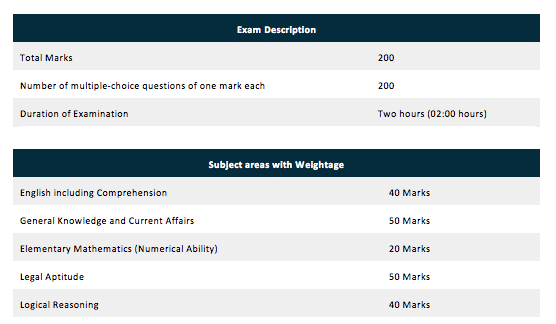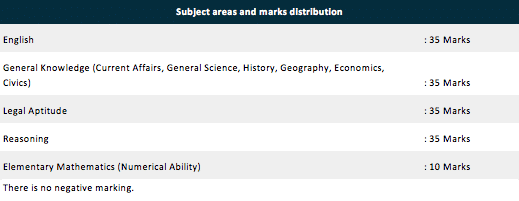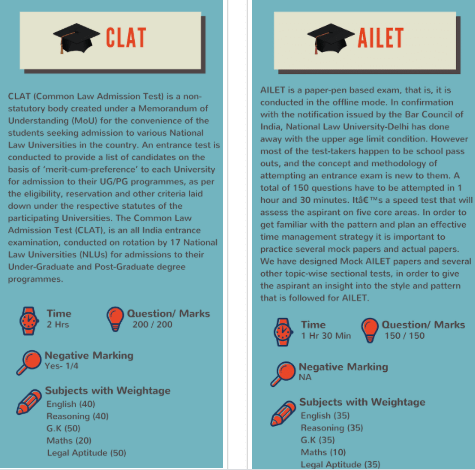
Last Updated on Nov 11, 2019
LAW entrance tests are conducted on a national, state or university level for admission to various law courses like BA LLB, LLM etc. The CLAT and AILET are the popular and toughest exams to obtain a seat in the top class NLUs (Law Universities) of India
CLAT
The Common Law Admission Test (CLAT) is an All India entrance examination for admission to the under-graduate and post-graduate degree programs of 17 National Law Universities.
The examination is conducted on rotation by 17 National Law Universities. The participating NLUs in the order of their establishment are:
1. National Law School of India University, Bangalore (NLSIU)
2. National Academy of Legal Study and Research University of Law, Hyderabad (NALSAR)
3. The National Law Institute University, Bhopal (NLIU)
4. The West Bengal National University of Juridical Sciences, Kolkata (WBNUJS)
5. National Law University, Jodhpur (NLUJ)
6. Hidayatullah National Law University, Raipur (HNLU)
7. Gujarat National Law University, Gandhinagar (GNLU)
8. Dr. Ram Manohar Lohiya National Law University, Lucknow (RMLNLU)
9. Rajiv Gandhi National University of Law, Punjab (RGNUL)
10. Chanakya National Law University, Patna (CNLU)
11. The National University of Advanced Legal Studies, Kochi (NUALS)
12. National Law University Odisha, Cuttack (NLUO)
13. National University of Study and Research in Law, Ranchi (NUSRL)
14. National Law University and Judicial Academy, Assam (NLUJAA)
15. Damodaram Sanjivayya National Law University, Visakhapatnam (DSNLU)
16. Tamil Nadu National Law School, Tiruchirappalli (TNNLS)
17. Maharashtra National Law University, Mumbai (MNLU)
Exam Format:
The pattern of CLAT (Under-Graduate Programme)
Mode of Testing: Computer Based Test (CBT)

Note: There shall be a system of Negative Marking wherein 0.25 marks will be deducted for each of the wrong answers.
Source: CLAT’s official website clat.ac.in
Eligibility Criteria for Appearing in CLAT
For UG Programme
1. Passed 10+2 or equivalent examination with the minimum of:-
(a) Forty-five percent (45%) marks in case of candidates belonging to Unreserved/OBC/ (Specially Abled Persons) Categories and
(b) Forty percent (40%) marks in case of candidates belonging to SC/ST Category
2. Candidates who are appearing in the qualifying examination in April/May are also eligible for appearing in the CLAT examination. However, they shall be required to produce evidence of their passing the qualifying examination at the time of admission, failing which they shall lose their right to be considered for admission.
3. No upper age limit is prescribed for appearing in CLAT
For PG Programme
1. LL.B. or equivalent degree in law examination with a minimum of 55% marks in case of Unreserved/OBC/ (Specially abled persons) categories and 50% marks in case of SC/ST category
2. Candidates who are appearing in the qualifying examination in March/April are also eligible for appearing in the CLAT examination. However, they shall be required to produce evidence of their passing the qualifying examination in the respective National Law Universities at the time of admission failing which they shall lose their right to be considered for admission.
3. No upper age limit is prescribed for appearing in CLAT
How should I prepare for CLAT?
The preparation of CLAT is very exhaustive. Over the years due to the increase in the number of students opting for the exam, the level of competition has increased considerably. One of the main aspects that would help you to prepare for the exam is to develop a habit of maintaining notes related to current affairs. The Static General Knowledge requires relevant material in History, Geography, Economics and General Sciences, and a proper understanding of basic legal concepts and legal reasoning along with basic and advanced concepts of Analytical and critical reasoning. Quantitative aptitudes consisting of Class X level concepts are required. All the mentioned sections should be practiced keeping in mind the time constraints. The CLAT exam does not have any structured syllabi to adhere to making it all though more challenging!
AILET
The All India Law Entrance Test is conducted for admission to the five-year under-graduate law program of National Law University Delhi. Every year more than thousands of candidates apply for the AILET exam and they want to make their career this field.
Exam Pattern:
Total Marks: 150
Total number of questions: 150
Duration of the Examination: 1 hour 30 minutes
Mode of Testing: Pen & Paper Test

Eligibility:
Education: The candidate should have passed the Higher Secondary School Examination (10+2) system or an equivalent examination thereto securing in the aggregate not less than 50% of the total marks. The Candidates appearing in the 12th Standard Examination in March/ April can also apply.
Candidates awaiting results of the qualifying examination can also appear for the test on condition that they produce proof of having passed the qualifying examination with the prescribed marks at the time of the interview. Those who do not clear the qualifying examination with the requisite marks will not be considered for admission. Candidates whose statement of marks of the qualifying examination is not available at the time of the interview are not eligible for admission.
The University reserves the right to cancel the admission of any candidate in accordance with rules. Candidates who get compartment in any subject in the qualifying examination are not eligible for admission in that year.
Age: Be less than 21 years of age on the First day of July of the year of admission. However, in cases of SC or ST candidates, the maximum age limit shall be 23 years as of the above date.
The candidate should have been selected in the All India Entrance Test held by National Law University, Delhi.
Syllabus for CLAT exam as below:
1. English including comprehension- The English section will test the candidates’ proficiency in English based on comprehension passages and grammar.
2. General Knowledge and Currents Affairs- The candidates will be tested on their general awareness including static general knowledge.
3. Mathematics- This section will test candidate’s knowledge on elementary mathematics, i.e. maths taught up to Class X.
4. Legal Aptitude- This section will test candidate’s interest towards the study of law, research aptitude and problem-solving ability. Questions will be framed with the help of legal propositions (described in the paper), and a set of facts to which the said proposition has to be applied. Some propositions may not be “true” in the real sense (e.g. the legal proposition may be that any person who speaks in a movie hall and disturbs others that are watching the movie will be banned from entering any movie theatre across India for one year). Candidates will have to assume the “truth” of these propositions and answer the questions accordingly.
The recent trends reflect that most of the questions will be Principle-fact based. The best way to attempt these questions is, do not make any assumptions outside the given legal principle and fact and stick to the theory that the principle is always right.
The legal fact and legal G.K questions can be attempted well by identification and memorization of important constitutional articles, landmarks and recent judgments and new laws/ amendments.
This section requires speed, especially the principle- fact questions, so practice mock tests and previous question papers.
5. Logical Reasoning- The purpose of the logical reasoning section is to test the candidate’s ability to identify patterns, logical links and rectify illogical arguments by including questions such as syllogisms, logical sequences, analogies, etc.
What I need to concentrate upon during last days’ preparation for AILET
Law exam aspirants need to prepare a schedule and stick to it in their last days’ preparation as it will help them in performing well in the exam.
Experts advise for concentrating on revising concepts. Law aspirants should now concentrate on revising concepts of the AILET syllabus and re-look their knowledge to be thorough with the revised concepts.
AILET Toppers also advocate for taking regular mock tests. Yashika Jain, AILET, AIR 8 says, “I used to take mock tests and practice last years’ question papers, regularly as it helped me in analyzing my preparation and move to the next level.”

Summary
In this blog post, we have explained how CLAT and AILET are different on the basis of eligibility criteria, syllabus, pattern and more.
We hope you liked our post. Share your views in the comment section below. For our online CLAT Course please click the link HERE.
